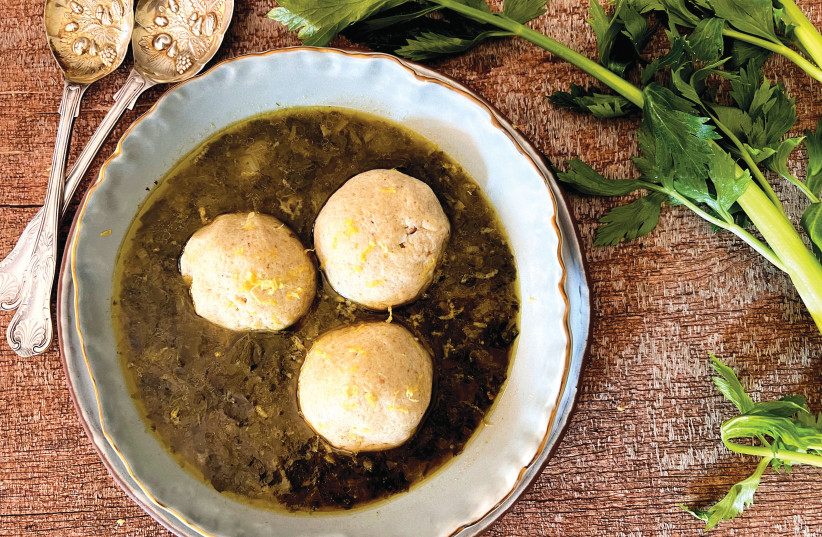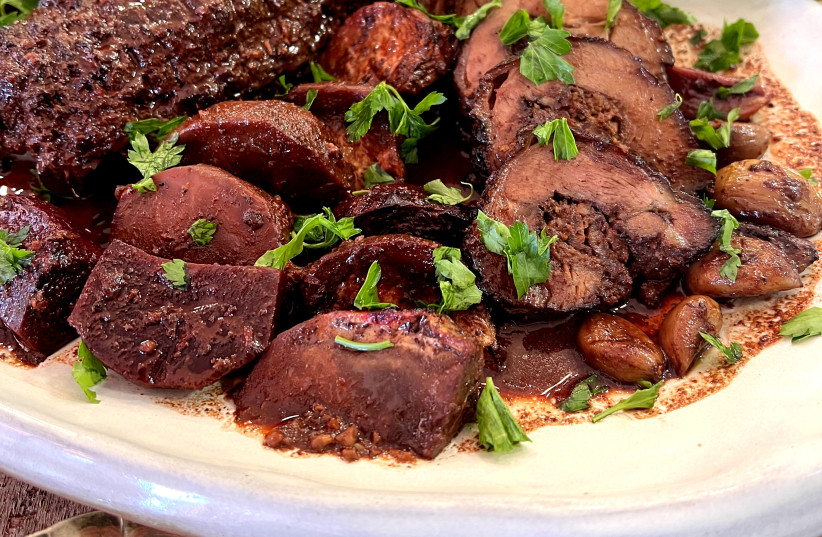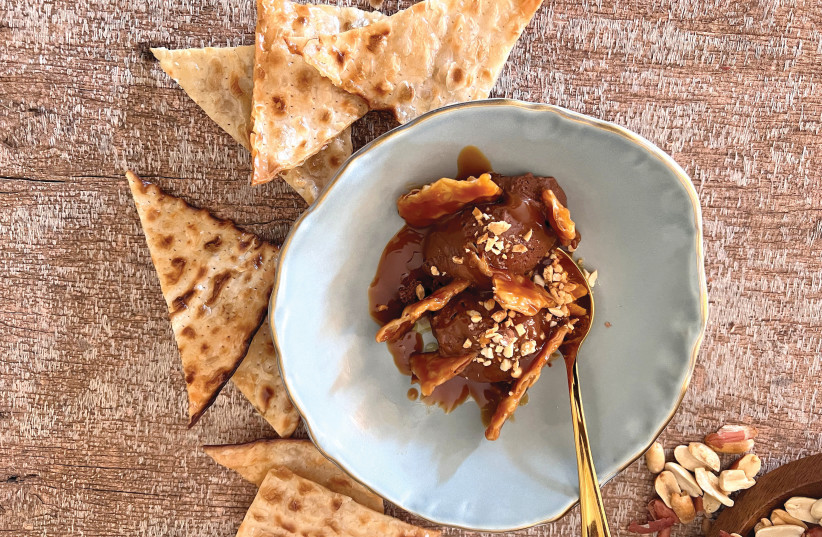One of my favorite things about what I do for a living is that I’m constantly meeting interesting people doing such creative work in the culinary world. And this week was one of the most exciting ever. In preparation for my Passover column, I invited chef Yaniv Gur Arye of Nahlaot Cuisine to join me in my kitchen to prepare a few festive dishes for the upcoming holiday.
Gur Arye, who completed a degree in culinary arts in the Faculty of Food Engineering at the Technion, is always collecting wild plants and developing and innovating new foodtech products. He teaches a course called Using Five Senses in the Kitchen, where he shares with participants the massive amount of information he’s learned over the years through trial and error in his kitchen, in university labs and while working in the food industry. Gur Aryeh involves all the senses, paying close attention to flavors, aromas, textures, appearance and sound – in short, all the ways in which food affects us.
For more of Pascale's recipes, click here>>
He teaches students how to create a dish, while balancing tradition and innovation, which is especially important as we prepare for the Seder meal we will all soon be sharing with family and friends. Ritual plays a significant role in the retelling of the Passover story of slavery to freedom as we continue traditions that are passed down from one generation to the next. Even as we adapt to new culinary cultures and strive to create gourmet dishes, there will always remain aspects of traditional foods we recall from our childhood.
In the spirit of the Festival of Freedom, blended together with family traditions, Gur Arye shared with me four fantastic kosher for Passover recipes. The first recipe is for fish-stuffed artichoke hearts in a sauce made from fava beans. Artichokes and fava beans are commonly featured in Moroccan Passover recipes. Once again, he blends East and West to create this dish, as he claims the ground fish in the artichoke heart is reminiscent of the Ashkenazi gefilte fish.
The second one is for wood sorrel and Swiss chard soup with chicken-stuffed matzah balls. Gur Arye created this recipe based on a Moroccan Passover kubbeh in sour sauce recipe he recalls from his childhood, which he then meshed with traditional Ashkenazi kneidlach (matzah ball) soup. He calls this new invention kubbelach.


The third dish, which he calls zeroa netuya (the outstretched arm that God used to take the Jews out of slavery in Egypt), is lamb shoulder stuffed with haroset, which symbolizes the mortar the Israelites used to make bricks in Egypt. This dish mirrors the “Hillel sandwich,” which is eaten during the reading of the Haggadah at the Seder meal, which brings together the sweet haroset and maror (bitter herbs). The celery in the recipe symbolizes the karpas, which is reminiscent of springtime and renewal, and is featured on the Seder plate, along with the horseradish, which is used for maror.
For dessert, Gur Arye has prepared a chocolate mousse, which is served with a drizzle of olive oil, pieces of matzah and coconut caramel cream. His inspiration for this dish was a dessert made with coconut flakes, whipped egg whites, peanuts and matzah dipped in syrup, which he remembers from growing up. This is his old/new version.
Wishing everyone a wonderful and delicious Passover!
FISH-STUFFED ARTICHOKE HEARTS IN FAVA BEAN SAUCE
Makes 8 servings.
Stuffed artichokes:
- 350 gr. fresh fish filet, skinless
- 1 onion, finely chopped
- 1 bunch of cilantro, chopped
- 1 Tbsp. matzah meal
- ¼ tsp. sweet paprika
- 1/8 tsp. nutmeg
- 1 tsp. salt
- 8 artichoke hearts (fresh or frozen), peeled and cleaned
Sauce:
- 1 kg. fava beans, peeled
- 3 Tbsp. olive oil
- 1 onion, chopped
- 2 cloves garlic, chopped
- 2 tomatoes, peeled and diced
- 1 Tbsp. pickled lemon, chopped
- 1 tsp. cumin
- ¼ tsp. turmeric
- 1 tsp. salt
- ¼ tsp. pepper
- ¼ tsp. coriander
Serving suggestion:
- Cilantro, chopped
To prepare the stuffed artichokes:
Chop finely or grind the fish and mix with the onion, cilantro, matzah meal, salt and paprika. Form balls and then press them into the artichoke hearts.
To prepare the sauce:
Blanch the fava beans in boiling water for 1 minute, then cool them down in ice water and remove the skins. Alternatively, you can use frozen pre-peeled beans.
Pour the olive oil into a large pan and sauté the onion and garlic until they’ve turned golden brown. Add the tomatoes, beans, pickled lemon, salt, pepper, turmeric and cumin and continue cooking another 3 minutes. Add water to cover and bring to a boil. Add the stuffed artichokes and cook over low heat for 20 minutes. You can add more water if necessary.
Add the coriander and cook another 5 minutes.
Garnish with cilantro and serve.
Level of difficulty: MediumTime: 1.5 hoursStatus: Parve


KUBBELACH: WOOD SORREL & SWISS CHARD SOUP WITH CHICKEN-STUFFED MATZAH BALLS
Makes 8 servings.
Soup:
- 2 packages wood sorrel
- 2 packages Swiss chard
- 4 Tbsp. olive oil
- 2 chicken thighs
- 1 onion, finely chopped
- 5 garlic cloves, chopped
- 1 package celery (stalks and leaves), chopped
- Salt, to taste
- 2 lemons, juice and zest
Matzah ball filling:
- 150 gr. chicken (from soup), ground
- 1 onion, chopped and sautéed in olive oil until it turns golden brown
- 2 Tbsp. cilantro, chopped
- 1 tsp. baharat (spice mixture)
- Salt, to taste
Matzah balls:
(Makes 16 balls with a diameter of 4-5 cm.)
- 4 medium eggs
- 1 tsp. salt
- Pinch baking soda
- Pinch turmeric
- 100 gr. matzah meal
- 100 ml. oil (or melted chicken or beef fat, olive oil or vegetable oil)
To make the soup:
Separate the white and green parts of the Swiss chard. Clean the white parts well, and chop the green pieces and the wood sorrel into large pieces.
Heat the olive oil in a large pan and sauté the chicken pieces on both sides until they’ve browned nicely. Remove them and put aside.
Add the onion, garlic, celery and white parts of the Swiss chard to the pan and sauté over low heat for 10 minutes until they soften and turn golden brown. Add a little salt and then return the chicken thighs to the pan. Add 2 liters of water to the pan and bring to a boil. Lower the heat, cover the pot and cook for 50 minutes.
Add the Swiss chard and wood sorrel. Cook for 30 more minutes. Taste and adjust seasoning. Add the lemon juice and zest and cook for another 10 minutes.
Remove the chicken pieces and let them cool completely before preparing the filling.
To prepare the filling: Pull the pieces of chicken off the bones with your fingers and chop the chicken finely. Mix the chopped chicken with the fried onion and cilantro, and season with baharat and salt. Mix well. Prepare 24 balls with the chicken mixture that weigh between 15 grams and 20 grams. Put the balls in the freezer so that they can set.
To make the matzah balls:
Add the eggs, salt, baking soda and turmeric to a bowl and mix well. Add the matzah meal and oil, and mix well.
Let the matzah ball mixture set in the fridge for 30 minutes. Form 24 matzah balls from the mixture. Flatten the matzah ball a little, and then press one of the frozen chicken balls into the matzah ball, and close matzah ball mixture around it so that the chicken ball is tucked inside. Prepare the rest of the matzah balls in the same fashion. Boil a pot of salted water. Once it begins to boil, add the matzah balls and cook over medium heat for 25 minutes. Prepare a bowl of ice water, and when the matzah balls have finished cooking, remove them and place them in the ice water to stop the cooking process.
When ready to serve, heat the soup, taste and add salt or lemon if necessary.
Add the matzah balls back to the soup and heat the soup for 5 minutes, then serve.
Level of difficulty: MediumTime: 3 hoursStatus: Meat


ZEROA NETUYA LAMB SHOULDER STUFFED WITH HAROSET
Makes 8 servings.
Haroset:
- 100 gr. whole almonds
- 100 gr. walnuts
- 75 gr. hazelnuts
- 75 gr. peanuts
- 1 tsp. ras el hanout or ground horseradish
- 400 gr. silan
- 100 gr. pomegranate concentrate
Lamb:
- 1 lamb shoulder (1.5 kg.-2 kg.). Ask butcher to separate meat from bone and to flatten. Cook bone with the meat.
- Salt and pepper, to taste
- 2 tsp. horseradish, grated
- 3 Tbsp. olive oil
- 1 bottle dry red wine
- 250 ml. water
- ½ tsp. ras el hanout
- ½ tsp. salt
- 4 celery roots, quartered
- 2 beets, cut into eighths
- 16 garlic cloves, whole in their skins
To prepare the haroset:
Place all the nuts in one layer on a tray and roast in an oven that has been preheated to 170° for 15-20 minutes until they turn golden brown.
Let them come back to room temperature, then grind them coarsely in a food processor.
Transfer the nut mixture to a bowl, and add the ras el hanout. Gradually add the silan and pomegranate concentrate while mixing until mixture becomes like a paste.
To prepare the lamb:
Slice the meat on your work surface, then sprinkle with salt and pepper. Spread a layer of haroset on the meat, then sprinkle horseradish on top. Roll the meat into a roll and secure with netting, which you can ask for at the butcher. Alternatively, you can secure the meat with a piece of cloth or string.
Heat the oil in a large pot and place the rolled-up lamb shoulder in the center. Sear on all sides until it’s golden brown. Remove and place on a plate. Add the bone to the pot and sear on all its sides. Next, pour the wine and water into the pot, and season with ras el hanout and salt. Bring to a boil and cook over low heat for 20 minutes.
Place the lamb and bone in a baking tray, then arrange the vegetables around the meat and bone and pour the wine mixture on top. Cover the pan with a lid or baking paper and then foil on top, securing the foil tightly.
Heat the oven to 150° and cook the lamb for 3 hours, basting meat and vegetables with juices from pan once during that time.
Remove the lamb from the pan and let it cool completely. If the gravy is too thin, continue reducing it on the stove top until it thickens.
Before serving, slice the lamb shoulder (it’s easier to slice when cold). Arrange the slices in a pan with the vegetables and heat for 10 minutes in an oven that was preheated to 170°.
Level of difficulty: Easy-mediumTime: 4.5 hoursStatus: Meat


CHOCOLATE MOUSSE, OLIVE OIL AND CARAMEL COCONUT MATZAH
Makes 8 servings.
Mousse:
- 200 gr. bittersweet chocolate 60% cocoa
- 125 ml. coconut cream
- ¼ tsp. salt
- ¼ tsp. cinnamon
- Small pinch of pepper (to enhance chocolate flavor)
- 2 egg whites
- 4 egg yolks
- 50 gr. sugar
- Caramel matzah:
- 2 pieces matzah
- ¼ cup olive oil for frying
- 200 gr. sugar
- 250 ml. coconut cream
- ½ tsp. salt
- 1 tsp. corn flour, dissolved in a little water
Toppings:
- Olive oil
- Chopped roasted peanuts
To prepare the mousse:
Place the chocolate, coconut cream and spices in a glass bowl and melt in the microwave for 30 seconds at a time, stirring in between each time. Remove from the microwave and stir in the egg yolks. In the bowl of an electric mixer, whip the egg whites with the sugar until stiff peaks form.
Gently fold the egg white mixture into the chocolate. Spoon the mousse into individual goblets or transfer to a serving bowl. Store in the fridge until serving.
To make the caramel matzah:
Wet the matzah pieces with water, then wrap them in a towel. Use a knife to cut each piece of matzah into 8 rectangles.
Heat the olive oil in a pan and fry the matzah pieces on both sides until they turn golden brown.
Take them out of the pan and place them on paper towels. Dissolve the sugar with a few spoonfuls of water until it turns an amber color.
Heat the coconut cream with the salt in a pot and bring it to a boil. Slowly pour the coconut cream into the caramel while stirring. Continue cooking the mixture for a few more minutes until it is smooth. Add the mixture to the corn flour mixture and stir. Just before serving, heat up the caramel sauce and then dip the matzah pieces in the caramel. Take a spoon and dip it in olive oil, then drizzle over the mousse and add a few pieces of caramel matzah. Drizzle a spoonful of caramel sauce over each serving of mousse, then sprinkle with roasted peanut pieces.
Level of difficulty: Easy-mediumTime: 1 hourStatus: Parve
Serving dishes: Courtesy TRÉS Tableware; 26 Hahadarim Road, Kfar Bilu; trestableware.com/
Translated by Hannah Hochner.
